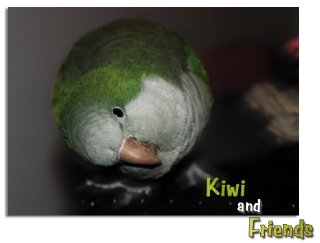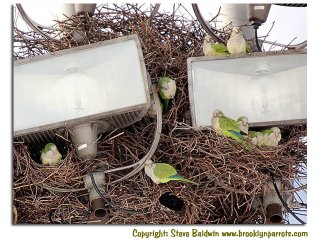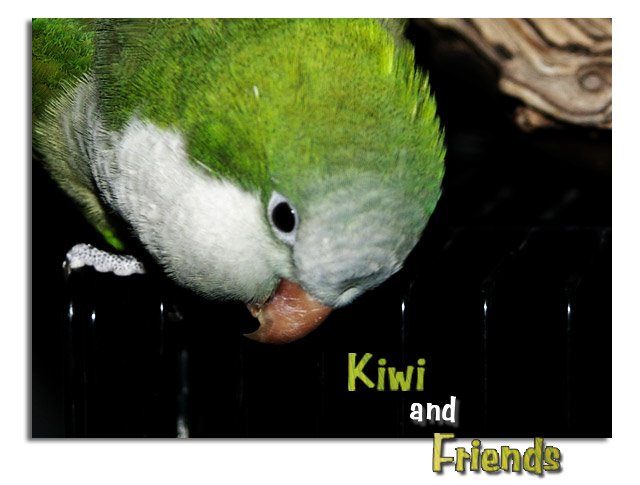
Given Names: Kiwi Salazar
Sex: Male (presumed)
Age: 3 years
Date of Birth: December 13, 2002
Place of Birth: Edmonton, Alberta, Canada
Common Name: Quaker Parakeet
Other Common Names: Monk Parakeet, Grey-Breasted Parakeet
Scientific Name: Myiopsitta monachus (Myo = fly, psitta = parrot, monachus = monk)
Taxonomy:
Species: monachus
Genus: Myiopsitta
Family: Psittacidae
Order: Psittaciformes
Class: Aves
Phylum: Chordata
Kingdom: Animalia
Subspecies: There are four recognized subspecies of Quakers in the wild. These are:
- Myiopsitta monachus monachus:
Range: Southeastern Brazil, Uruguay and northeastern Argentina
Wing length (measured from the bend of the wing to the tip of the longest primary): 14.1 - 16.1 cm
Weight: 120 g
Note: Largest subspecies of Quaker. Since most Quakers were exported from within the range of this subspecies most pets in the North America should belong to this subspecies.
- M. m. calita
Range: Western Argentina
Wing length: 13.6 - 14.4 cm
Weight: 100g
Note: The size difference is the best way to tell this from M. m. monachus. If your bird is small it may be this subspecies or M. m. cotorra (see below).
- M. m. cotorra
Range: Southeastern Bolivia, Paraguay and southern Brazil
Wing length: 13.1 - 14.7 cm
Weight: 100g
Note: This subspecies and calita are very hard to distinguish. M. m. cotorra supposedly is brighter green above and have less yellow below than calita.
- M. m. luchsi (a.k.a. the Cliff Parakeet)
Range: Central Bolivia, geographically isolated from all other subspecies
Wing length: 14.6 - 16.3 cm
Note: This is best told from the others by its distinctive plumage. The gray of the breast is uniform, not scaled. On all other subspecies the breast feathers are darker gray in the center with a lighter border giving the breast a scaled appearance. In addition, the gray on the forehead is whiter and extends to the mid crown in M. m. luchsi. The band on the upper abdomen is also purer yellow.
This bird gets its name because it builds its stick nests on cliffs in the deep valleys where it lives. This bird has recently been considered a different species Myiopsitta luchsi the Cliff Parakeet by Collar 1997
 Quakers are sexually mature at one to two years of age. Quakers are the only parrots known to build nests (all other parrots lay eggs in the hollows of trees). Male Quakers build nests consisting of three chambers: first, an incubation room (the deepest room in the nest) where eggs are laid, incubated and where chicks are fledged, second, a middle room or “living space” where chicks live after their first month and until they leave the nest, and third a “porch” area where the parents guard the nest. Quakers are famous for their nest building skills. These parrots are also known for building their nests in large colonies where mating pairs simply add to existing nests. The resulting colony resembles large apartment complexes with separate apartment units. The nests are built from twigs, leaves, small braches, and any suitable building material available. Egg clutches on average range between four to eight eggs with chicks hatching after 23 to 26 days. Chicks are fledged and leave the nest after only 6 - 8 weeks. Like many parrots Quakers begin to nurse their next clutch four weeks after their previous clutch is laid. They are prolific breeders capable of breeding all year round in captivity. Quakers as Pets: Quakers make excellent pets. As members of the psittacine family of birds Quaker are highly intelligent, capable of learning and adapting to any home environment. Like all psittacines they are social birds that enjoy companionship and spending as much time as possible with their adopted human flock. Ranked third only after African Greys and Amazons Quakers are fantastic talkers. Often these birds need only hear a sound once before adapting a limited vocal chord biology to mimic the perceived sound pattern. Although mimicking abilities wane after their second or third year some birds are reported to continue to learn words and short phrases into old age. It isn’t always the case but it is generally true to say that the larger the horn the louder the honk. Being small parrots Quakers are generally not very loud although they can cause a raucous when upset or when in need of some attention. Most vocalizations are moderate ranging from natural calls to practicing human and other foreign sounds at tolerable tones- often practicing for hours until being satisfied with the Memorex- uh-hum, Quakerex copy. The pet market delivers a wide range of foods for pet parrots. Although in the wild Quakers are largely seedeaters in captivity the best nutrition is provided by pelletized or “extruded” diets. These ensure that pets receive the same nutritional content in every bite. A well-socialized, well-fed and well cared for Quaker is less likely to develop social, physical and/or psychological problems. These include: biting, screaming, feather plucking, extreme shyness, extreme territorialism, and a large variety of nutrition related maladies. With an abundant source of energy and a contagious joie de vivre Quakers make enjoyable pets. They are affectionate, celebrated acrobats, escape artists and all around clowns who enjoy interacting in every aspect of human life. They are not cage birds. Sensitive pet owners include their Quakers in many of their day-to-day activities.
Quakers are sexually mature at one to two years of age. Quakers are the only parrots known to build nests (all other parrots lay eggs in the hollows of trees). Male Quakers build nests consisting of three chambers: first, an incubation room (the deepest room in the nest) where eggs are laid, incubated and where chicks are fledged, second, a middle room or “living space” where chicks live after their first month and until they leave the nest, and third a “porch” area where the parents guard the nest. Quakers are famous for their nest building skills. These parrots are also known for building their nests in large colonies where mating pairs simply add to existing nests. The resulting colony resembles large apartment complexes with separate apartment units. The nests are built from twigs, leaves, small braches, and any suitable building material available. Egg clutches on average range between four to eight eggs with chicks hatching after 23 to 26 days. Chicks are fledged and leave the nest after only 6 - 8 weeks. Like many parrots Quakers begin to nurse their next clutch four weeks after their previous clutch is laid. They are prolific breeders capable of breeding all year round in captivity. Quakers as Pets: Quakers make excellent pets. As members of the psittacine family of birds Quaker are highly intelligent, capable of learning and adapting to any home environment. Like all psittacines they are social birds that enjoy companionship and spending as much time as possible with their adopted human flock. Ranked third only after African Greys and Amazons Quakers are fantastic talkers. Often these birds need only hear a sound once before adapting a limited vocal chord biology to mimic the perceived sound pattern. Although mimicking abilities wane after their second or third year some birds are reported to continue to learn words and short phrases into old age. It isn’t always the case but it is generally true to say that the larger the horn the louder the honk. Being small parrots Quakers are generally not very loud although they can cause a raucous when upset or when in need of some attention. Most vocalizations are moderate ranging from natural calls to practicing human and other foreign sounds at tolerable tones- often practicing for hours until being satisfied with the Memorex- uh-hum, Quakerex copy. The pet market delivers a wide range of foods for pet parrots. Although in the wild Quakers are largely seedeaters in captivity the best nutrition is provided by pelletized or “extruded” diets. These ensure that pets receive the same nutritional content in every bite. A well-socialized, well-fed and well cared for Quaker is less likely to develop social, physical and/or psychological problems. These include: biting, screaming, feather plucking, extreme shyness, extreme territorialism, and a large variety of nutrition related maladies. With an abundant source of energy and a contagious joie de vivre Quakers make enjoyable pets. They are affectionate, celebrated acrobats, escape artists and all around clowns who enjoy interacting in every aspect of human life. They are not cage birds. Sensitive pet owners include their Quakers in many of their day-to-day activities.Further on-line reading:
http://www.brooklynparrots.com http://www.peteducation.com/article.cfm?cls=15&cat=1840&articleid=2389 http://www.holisticbirds.com/Hbn02/spring02/pages/quaker1.htm http://invasions.bio.utk.edu/invaders/monk.html http://www.duke.edu/~djb4/Monk%20Parakeets.htm

No comments:
Post a Comment